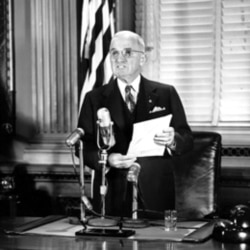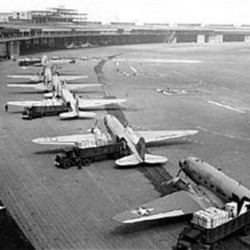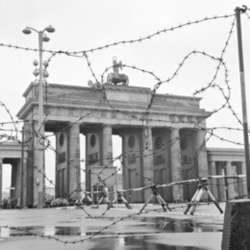STEVE EMBER: Welcome to THE MAKING OF A NATION – American history in VOA Special English. I’m Steve Ember.
(MUSIC)
Today, we tell about the period known as the Cold War.
The Cold War began after World War Two. The main enemies were the United States and the Soviet Union.
The Cold War got its name because both sides were afraid of fighting each other directly. In a "hot war," nuclear weapons might destroy everything. So, instead, both sides fought each other indirectly. They supported opposing sides in conflicts in different parts of the world. They also used words as weapons. They threatened and denounced each other. Or they tried to make each other look foolish.
Over the years, leaders on both sides changed. Yet the Cold War continued. It was the major force in world politics for most of the second half of the twentieth century.
The Cold War world was separated into three groups. The United States led the West. This group included countries with democratic political systems. The Soviet Union led the East. This group included countries with communist political systems. The non-aligned group included countries that did not want to be tied to either the West or the East.
(MUSIC)
Harry Truman was the first American president to fight the Cold War. He used several policies. One was the Truman Doctrine. This was a plan to give money and military aid to countries threatened by communism. The Truman Doctrine effectively stopped communists from taking control of Greece and Turkey.
Another policy was the Marshall Plan. This strengthened the economies and governments of countries in western Europe.
A major event in the Cold War was the Berlin Airlift. After World War Two, the United States and its allies divided Germany. Berlin was a part of communist East Germany. The city was divided into east and west.
In June nineteen forty-eight, Soviet-led forces blocked all roads and railways leading to the western part of Berlin. President Truman quickly ordered military airplanes to fly coal, food, and medicine to the city.
(SOUND)
The planes kept coming, sometimes landing every few minutes, for more than a year. The United States received help from Britain and France. Together, they provided almost two and one-half million tons of supplies on about two hundred-eighty thousand flights.
The United States also led the formation of the North Atlantic Treaty Organization in nineteen forty-nine. NATO was a joint military group. Its purpose was to defend against Soviet forces in Europe.
The Soviet Union and its east European allies formed their own joint military group -- the Warsaw Pact -- six years later.
In nineteen fifty-three, Soviet leader Josef Stalin died. His death gave the new American president, Dwight Eisenhower, a chance to deal with new Soviet leaders.
(MUSIC)
In July nineteen-fifty-five, Eisenhower and Nikolai Bulganin met in Geneva, Switzerland. The leaders of Britain and France also attended.
Eisenhower proposed that the Americans and Soviets agree to let their military bases be inspected by air by the other side. The Soviets later rejected the proposal. Yet the meeting in Geneva was not considered a failure. After all, the leaders of the world's most powerful nations had shaken hands.
Cold War tensions increased, then eased, then increased again over the years. The changes came as both sides attempted to influence political and economic developments around the world.
For example, the Soviet Union provided military, economic, and technical aid to communist governments in Asia. The United States then helped eight Asian nations fight communism by establishing the Southeast Asia Treaty Organization, known as SEATO.
In the nineteen fifties, the United States began sending military advisers to help South Vietnam defend itself against communist North Vietnam. That aid would later expand into a long and bloody period of American involvement in Vietnam.
The Cold War also affected the Middle East. In the nineteen fifties, both East and West offered aid to Egypt to build the Aswan High Dam on the Nile River. The West cancelled its offer, however, after Egypt bought weapons from the communist government in Czechoslovakia.
Egyptian President Gamal Abdel Nasser then seized control of the company that operated the Suez Canal.
(SOUND)
A few months later, Israel invaded Egypt. France and Britain joined the invasion.
For once, the United States and the Soviet Union agreed on a major issue. Both supported a United Nations resolution demanding an immediate ceasefire.
The Suez crisis was a political victory for the Soviets. When the Soviet Union supported Egypt, it gained new friends in the Arab world.
In nineteen fifty-nine, cold war tensions eased a little. The new Soviet leader, Nikita Khrushchev, visited Dwight Eisenhower in the United States. The meeting was very friendly. But the next year, relations got worse again.
(MUSIC)
An American U-2 reconnaissance airplane was shot down over the Soviet Union. The plane and its pilot, Francis Gary Powers, were captured. Eisenhower admitted that such planes had been spying on the Soviets for four years. In a speech at the United Nations, Khrushchev got so angry that he took off his shoe and beat it on a table.
John Kennedy followed Eisenhower as president in nineteen sixty-one. During his early days in office, Cuban exiles invaded Cuba. It came to be known as the Bay of Pigs invasion. The forces wanted to oust the communist government of Fidel Castro.
America's Central Intelligence Agency had provided training for the exiles. But the United States failed to send military planes to protect them during the invasion. As a result, almost all were killed or taken prisoner by Cuban forces trained and supported by the Soviet Union and its allies.
At the same time in Europe, tens of thousands of East Germans had fled to the West. East Germany's government decided to stop them. It built a wall separating the eastern and western parts of the city of Berlin. Guards shot at anyone who tried to flee by climbing over.
During Kennedy's second year in office, American intelligence reports discovered Soviet missiles in Cuba.
JOHN F. KENNEDY: “This government, as promised, has maintained the closest surveillance of the Soviet military build-up on the island of Cuba. Within the past week, unmistakable evidence has established the fact that a series of offensive missile sites is now in preparation on that imprisoned island. The purpose of these bases can be none other than to provide a nuclear strike capability against the western hemisphere.”
The Soviet Union denied the missiles were there. Yet American photographs, taken from high in the air, proved they were.
America’s ambassador to the United Nations, Adlai Stevenson:
ADLAI STEVENSON: “Let me ask you one simple question: Do you, Ambassador Zorin, deny that the USSR [Soviet Union] has placed and is placing medium- and intermediate-range missile and sites in Cuba. Yes or no? Don’t wait for the translation. Yes or no?”
SOVIET AMBASSADOR VALERIAN ZORIN: “Mr. Stevenson, would you continue your statement, please? You will receive the answer in due course, do not worry.”
ADLAI STEVENSON: “I’m prepared to wait for my answer until hell freezes over, if that’s your decision. And I’m also prepared to present the evidence in this room.”
(MUSIC)
The Cuban missile crisis easily could have resulted in a nuclear war. Americans felt especially threatened, with those missiles just one hundred fifty kilometers from the Florida coast. But the crisis ended after a week. Khrushchev agreed to remove the missiles if the United States agreed not to interfere in Cuba.
Some progress was made in easing Cold War tensions when Kennedy was president. In nineteen sixty-three, the two sides reached a major arms control agreement. They agreed to ban tests of nuclear weapons above ground, under water, and in space. They also established a direct telephone link between the White House and the Kremlin.
Relations between East and West also improved when Richard Nixon was president. He and Leonid Brezhnev met several times. They reached several arms control agreements. One reduced the number of missiles used to shoot down enemy nuclear weapons. It also banned the testing and deployment of long-distance missiles for five years.
A major change in the Cold War would take place in nineteen eighty-five, when Mikhail Gorbachev became leader of the Soviet Union. He met four times with President Ronald Reagan. Gorbachev withdrew Soviet forces from Afghanistan. And he signed an agreement with the United States to destroy all middle-distance and short-distance nuclear missiles.
By nineteen-eighty-nine, there was widespread unrest in eastern Europe. Gorbachev did not intervene as one eastern European country after another cut its ties with the Soviet Union.
The Berlin Wall, the major symbol of communist oppression, was torn down in November of that year. In less than a year, East and West Germany became one nation again. A few months after that, Warsaw Pact countries officially ended the alliance. The Cold War was over.
The Cold War years were also the time of the “space race” – when the United States and the Soviet Union competed in space exploration. That will be our story next week.
You can find our series online with transcripts, MP3s, podcasts and pictures at voaspecialenglish.com. I’m Steve Ember, inviting you to join us again next week for THE MAKING OF A NATION -- American history in VOA Special English.
___
Contributing: Jerilyn Watson
This was program #207. For earlier programs, type "Making of a Nation" in quotation marks in the search box at the top of the page.







